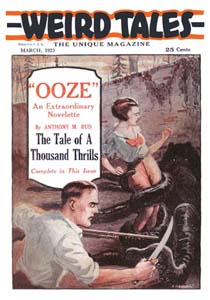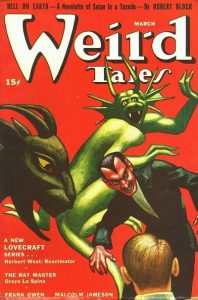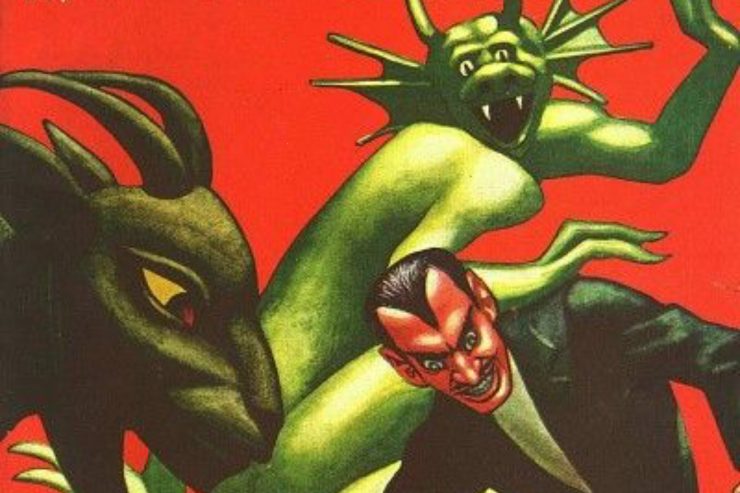 Weird Tales was the first periodical specifically devoted to the fantasy genre. Premiering in early 1923, its publishers envisioned “The Unique Magazine” as a place for a writer to be given “free rein to express his innermost feelings in a manner befitting great literature.” In reality, the early issues of the pulp were filled with ghost stories, the choice of the magazine’s editor, Edwin Baird. Far more interested in Rural’s Real Detective and Mystery Stories, Baird had little interest in fantasy.
Weird Tales was the first periodical specifically devoted to the fantasy genre. Premiering in early 1923, its publishers envisioned “The Unique Magazine” as a place for a writer to be given “free rein to express his innermost feelings in a manner befitting great literature.” In reality, the early issues of the pulp were filled with ghost stories, the choice of the magazine’s editor, Edwin Baird. Far more interested in Rural’s Real Detective and Mystery Stories, Baird had little interest in fantasy.
Weird Tales came into its own in late 1924 when Farnsworth Wright was named the magazine’s editor. In the years ahead, the pulp would become known for its fantasy and supernatural fiction, publishing the work of Robert E. Howard, H. P. Lovecraft, and Clark Ashton Smith. Later issues would feature substantial efforts by Robert Bloch, Ray Bradbury, Carl Jacobi, Henry Kuttner, C. L. Moore, Seabury Quinn, Manly Wade Wellman, and others. Weird Tales would likewise become noted for its artists. Hannes Bok, Margaret Brundage, Lee Brown Coye, and Virgil Finlay all contributed greatly to the fantasy art field through their work for “The Unique Magazine.”
In addition to publishing some of the best fantasy and supernatural fiction of the twentieth century, Weird Tales, like the Munsey magazines, featured science fiction in its pages, offering tales of interplanetary expeditions, brain transference, death rays, lost races, parallel worlds, and more. Edmond Hamilton was its leading contributor of science fiction. With stories about alien invasions, space police, and evolution gone wild, the author became known as “world-wrecker” Hamilton. Other notable science fiction in Weird Tales included work by Austin Hall, Otis Adelbert Kline, Frank Belknap Long, C. L. Moore, Donald Wandrei, and Jack Williamson. In his later years, H. P. Lovecraft spun his own style of science fiction in his tales of cosmic horror.
Although science fiction was frequently found in its pages—particularly during its early years—Weird Tales was not the first science-fiction pulp. That was left for Hugo Gernsback, an immigrant from Luxembourg, to develop.
 The original run of Weird Tales began with its March 1923 number and ran through its September 1954 issue, for a total of 279 issues. Edwin Baird, Farnsworth Wright, and Dorothy McIlwraith (beginning in May 1940) were its editors. It was revived in 1973-74 for four issues, edited by Sam Moskowitz. A paperback series lasting four more issues, edited by Lin Carter, appeared from 1981-1983. The magazine was revived in 1988 by George H. Scithers, Darrell Schweitzer and John Gregory Betancourt and has, more or less, been published on a continuous basis since that time. At this writing, the 361st issue had been released. It is currently published by John Harlacher with Marvin Kaye serving as editor. For more details, visit the magazine’s website at http://weirdtalesmagazine.com/.
The original run of Weird Tales began with its March 1923 number and ran through its September 1954 issue, for a total of 279 issues. Edwin Baird, Farnsworth Wright, and Dorothy McIlwraith (beginning in May 1940) were its editors. It was revived in 1973-74 for four issues, edited by Sam Moskowitz. A paperback series lasting four more issues, edited by Lin Carter, appeared from 1981-1983. The magazine was revived in 1988 by George H. Scithers, Darrell Schweitzer and John Gregory Betancourt and has, more or less, been published on a continuous basis since that time. At this writing, the 361st issue had been released. It is currently published by John Harlacher with Marvin Kaye serving as editor. For more details, visit the magazine’s website at http://weirdtalesmagazine.com/.
To learn more about the images used in this post, click on the illustrations. Click here for references consulted for this article.







